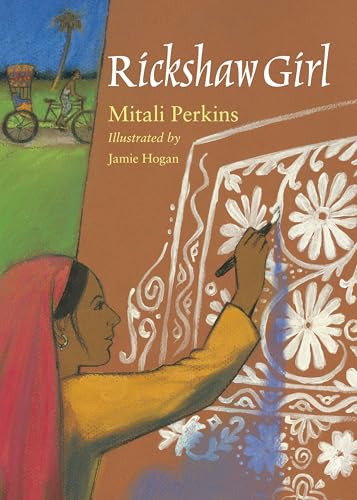Then a UPS truck pulls up in front of my house. A package? For me? Yes indeedy. It’s special delivery for MotherReader. Now, I don’t get many books from authors or publishers. If I’m asked to look at a book, I generally do. Once in a while, I ask the author or publisher for a book — but only if I have some confidence that I’ll like it.
 In this case, it was a book I had requested — Rickshaw Girl, by Mitali Perkins. I had loved her book Monsoon Summer and had recommended it for my county’s 2006 summer reading program. Monsoon Summer was such an interesting and engaging look at India through the eyes of an Americanized teenage girl. I loved the way the reader could get a feel for the problems of India, without the book feeling preachy. With the new take on another culture and the accessibility to younger teens, Monsoon Summer was a great choice for our summer reading list and continues to be a standard recommendation of mine.
In this case, it was a book I had requested — Rickshaw Girl, by Mitali Perkins. I had loved her book Monsoon Summer and had recommended it for my county’s 2006 summer reading program. Monsoon Summer was such an interesting and engaging look at India through the eyes of an Americanized teenage girl. I loved the way the reader could get a feel for the problems of India, without the book feeling preachy. With the new take on another culture and the accessibility to younger teens, Monsoon Summer was a great choice for our summer reading list and continues to be a standard recommendation of mine.So, when I opened today’s package and found Rickshaw Girl, I did something I never do. I stopped reading the book I had out, mid-chapter — maybe even mid-sentence — and read this book.
I was not disappointed.
Naima is a girl on the verge of heading out of the salwar kameez (long-sleeved tunics over cotton pants) and into a saree (yards of fabric wrapped around and over the shoulder), living in Bangladesh with her mother, father, and little sister. Her father drives a rickshaw to support the family, but without a son to help with the work, it’s hard to make enough money to pay back the cost of the new rickshaw. Naima wants to help, but as a girl she isn’t allowed. She does make lovely alpanas, the painted patterns done on the family’s paths and thresholds — even winning a prize for the best alpana in her village on International Mother Language Day.
Knowing her family is in trouble, Naima tries to help. Unfortunately, she only succeeds in making things worse. But after pulling back into her domestic role, she finds that her drive, her mind, and her talents can push her toward success for herself and for her family.
Rickshaw Girl is written for a younger audience than Monsoon Summer, which did throw me for a few pages. I was expecting another Young Adult book. But after I got into the book, I really enjoyed the story. As an adult, I could certainly see where the plot was going, but I wasn’t bothered by it. The strength of the book is in showing another culture without it feeling like a lesson. While Mitali includes a glossary in the back — with pictures — she relies on context and short descriptions in the story to keep the reader informed. She also has an author’s note in the back about the importance of mini-loans in these developing rural areas, and the strong role that women are playing in the local economies.
I’m looking forward to giving it to my daughter to read, and perhaps even to her teacher to read to the class. For everyone else looking for a good book on South Asian culture and Girl Power, Bengal style, put Rickshaw Girl on your wish list for 2007.
























4 comments:
National Children's Book Week is coming.
Celebrate locally here:
http://www.nasm.si.edu/events/eventDetail.cfm?eventID=527
The last line of your review--For everyone else looking for a good book on Indian culture and Girl Power, Bengal style, put Rickshaw Girl on your wish list for 2007--is very confusing. Naima is Bangladeshi, not Indian, although at one point Bangladesh was part of India (pre-1947) and yes, West Bengal is a state in India.
I loved the book, I loved your review, and I don't mean to nitpick, but I just want to make sure that a great book like this is acurately depicted on a blog I love so much!
Actually, thanks for nitpicking since it is an important point. I'm changing my reference to "South Asian culture" based on this Wikipedia entry (if anyone else wants more info):
Bangladesh, officially the People's Republic of Bangladesh, is a country in South Asia. It is surrounded by India on all sides except for a small border with Myanmar to the far southeast and the Bay of Bengal to the south. Together with the Indian state of West Bengal, it makes up the ethno-linguistic region of Bengal. The name Bangladesh means "Country of Bengal."
Love your blog! I am regular visitor. I keep checking often for updates! I have my own multi-cultural children's book blog started by a group of us.
Thanks for your wonderful work!
Praba
Post a Comment